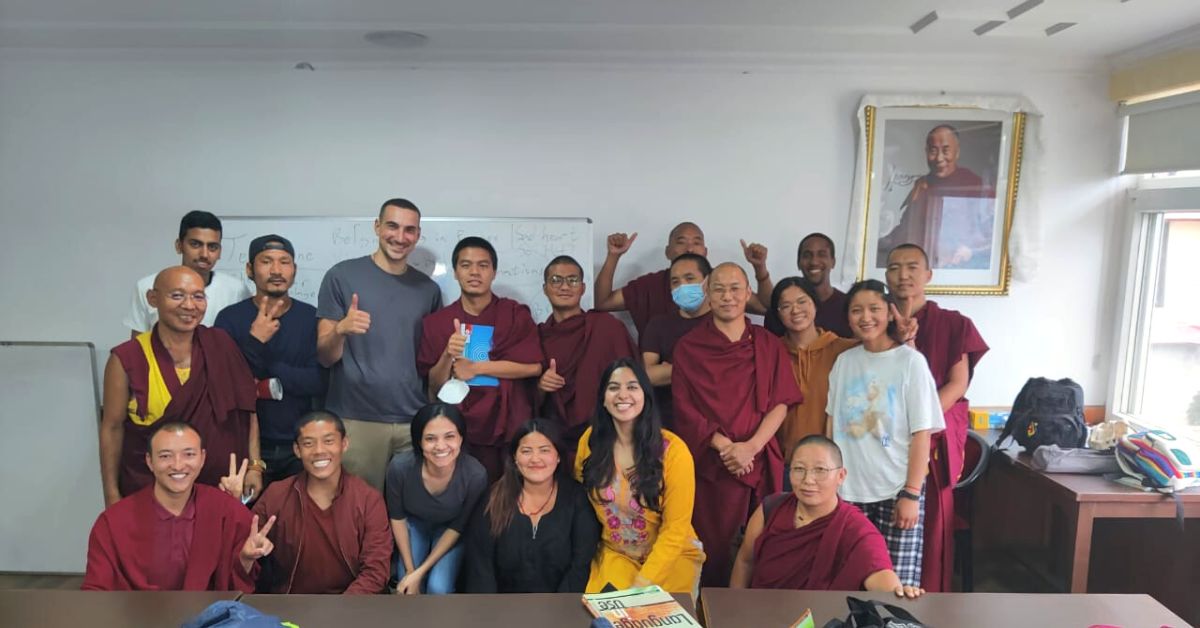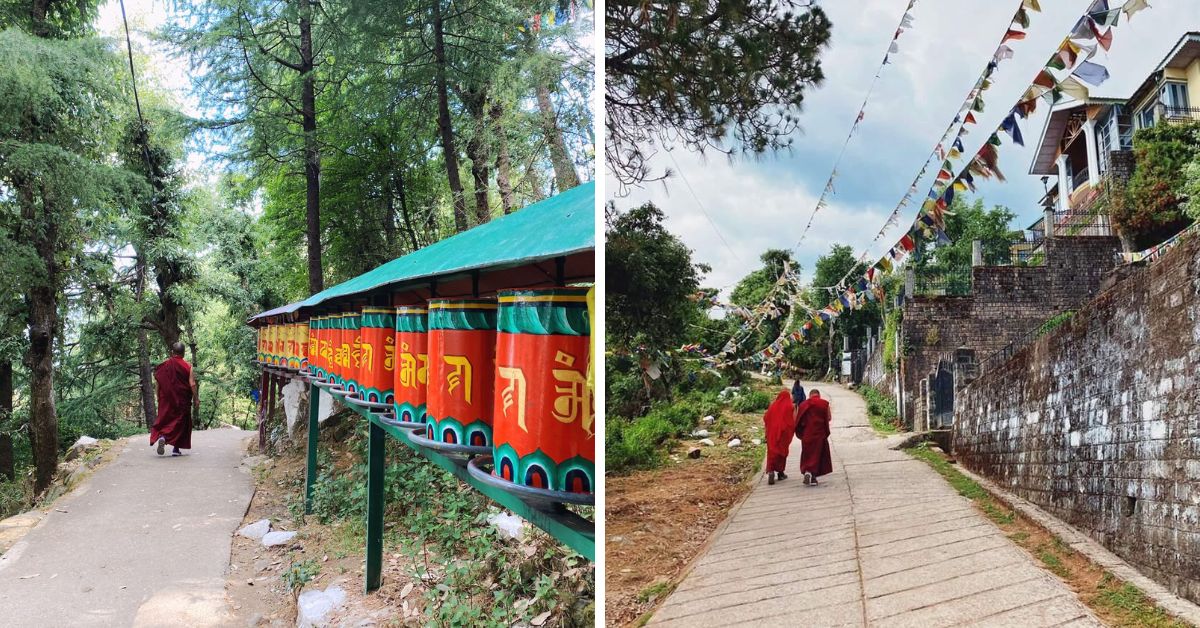My Life-Changing Experience of Volunteering With Tibetan Refugees & How You Can Too
Lha Charitable Trust in Himachal Pradesh was founded by a group of Tibetan refugees to help the scores of Tibetans coming to India without formal education. Here’s what volunteering at the Trust looks like.

“Buddhist philosophy says we are all here because we’ve met in a past life,” Tendar (‘like soft’ as he likes to say), a young Tibetan refugee monk, tells me. It was this comforting thought that left me feeling like I wasn’t among strangers for the first time in 24 hours.
I had signed up with Lha Charitable Trust in Dharamshala, Himachal Pradesh, to volunteer to teach English conversation classes to the monks, Tibetan refugees, and locals in Mcleodganj. Less than a month later, I was here in the mountains having enlightening conversations amid breathtaking views of coniferous trees, snow-capped peaks, and colourful flora and fauna.
Our conversations ranged from everything theoretical like Buddhist philosophy to entertaining bits like Tollywood movies and superstar Rajinikanth. Oftentimes, topics for discussions in class would take unexpected and hilarious turns, like the time we discussed ‘the unexplained’ — paranormal activities or supernatural events. But one monk friend in the group took the term for its literal meaning, and innocently asked if this meant that a ‘dumb’ (mute) person wouldn’t be able to explain what they were eating.
The English conversation classes are conducted by Okechukwu, an American professor who has dedicated 10 years of his life to the cause. He tells me that he makes a trip every other year when time permits. His manner of teaching the class is quite unconventional, with fun games like ‘Telephone’ (or as we know it by its sinophobic name, ‘Chinese whispers’) and ‘Shiritori’, a Japanese game that is very similar to Antakshari, but with words.
Volunteers split up and lead groups of five students or so to discuss the topic for the day in detail. At the end of the class, the monks are asked to share their views with the rest. These constant discussions and practice sessions help them enhance their English speaking skills.
While some in the class are able to articulate their views on the oppression of Tibet, His Holiness the Dalai Lama, and world politics, others like sweet Remchin still struggle with the nuances of the language. She is comfortable practising basics like asking someone about their day, ordering the specials from a menu, and talking about the beautiful Mcleodganj weather.
I am learning Tibetan from her. So far, I know the Tibetan word for heart, ‘ning’, and beautiful, which is ‘dolkar’. Other times, we are exhausted trying to communicate with our own language of hand gestures and dumb charades.
Classes typically last an hour, from 4 pm to 5 pm.
But this isn’t the only way one can volunteer at Lha.
How you can help

Since its inception in 1997, Lha has strived to help thousands of Tibetan refugees who make their way to India, having had limited formal education and communicating only in Tibetan.
Initially named Louisiana Himalaya Association (LHA), it was founded by a small group of Tibetan refugees and their friends in New Orleans, Louisiana in the USA. It was managed by Jampa Tsering, a refugee, and Neil Guidry, a social work professor from New Orleans.
In 2005, Lha Charitable Trust was registered as a separate non-profit social work organisation and charitable trust through the District of Kangra, Himachal Pradesh (The Tibetan meaning of the word ‘Lha’ is ‘primordial pristine awakened mental state’).
Volunteers and resources from Louisiana began assisting the newly arriving Tibetan refugees in Dharamshala. They started with teaching the English language to the newly arrived Tibetan adults and general assistance for elderly Tibetans.
Lha has hosted 10,000 volunteers thus far. This number has dwindled during the pandemic for obvious reasons. However, Lha’s website claims that on average they have “hosted around 15-20 volunteers daily”, assisting in many activities.
Some of the activities include teaching English, French, Chinese, German and Tibetan; writing news articles on Tibetan issues; and writing content for their website, social media management, and environmental research projects.
All the language classes run for a minimum of three months. However, one can specify the duration they would like to volunteer for. Additionally, volunteers with certificates of language teaching — such as Teaching English as a Second Language (TESL) or Teaching English as a Foreign Language (TEFL) — will be given preference.
Lha is also open to professionals interested in designing products and Tibetan traditional clothing for their handicraft shop — Lha Tibet Fair Trade Pvt Ltd.

Credit: Blake D’silva
In the early 2000s, Lha acquired ‘Ahimsa house’, which is a 10-minute downhill walk from the home and temple of His Holiness, the Dalai Lama. The four-storey building now hosts all the classes and a cosy ‘Ahimsa cafe’, where one can get the best Tibetan treats, some teacakes, and good coffee.
Towards the end of my volunteering days at Lha, I discovered the Kora circuit — a type of meditative practice walk for Tibetan pilgrims — thanks to my monk students. ‘Kora’ is a Tibetan word which means ‘circumambulation’ or ‘revolution’. It is a downhill path lined with tall trees — which are home to a troop of monkeys — prayer flags, and chortens. Pilgrims walk clockwise, turning the prayer wheels that come in all shapes, sizes, and colours.
The 20-25 minute walk takes you around the Dalai Lama temple and His Holiness’ residence.
On the Kora path after classes end, the monks prefer to discuss more topics of conversation to help them practice, and I enjoy their company while I continue to learn the Tibetan language in exchange. Lobsung, another Tibetan monk student, asks me what my goal in life is. I answer with another question: How do you say ‘to be happy’ in Tibetan? He replies with a smile, “Ki po jey”.
For more information about volunteering opportunities at Lha Charitable Trust click here; To sign up for their volunteering programmes click here.
(Edited by Divya Sethu)
If you found our stories insightful, informative, or even just enjoyable, we invite you to consider making a voluntary payment to support the work we do at The Better India. Your contribution helps us continue producing quality content that educates, inspires, and drives positive change.
Choose one of the payment options below for your contribution-
By paying for the stories you value, you directly contribute to sustaining our efforts focused on making a difference in the world. Together, let’s ensure that impactful stories continue to be told and shared, enriching lives and communities alike.
Thank you for your support. Here are some frequently asked questions you might find helpful to know why you are contributing?


This story made me
-
97
-
121
-
89
-
167











